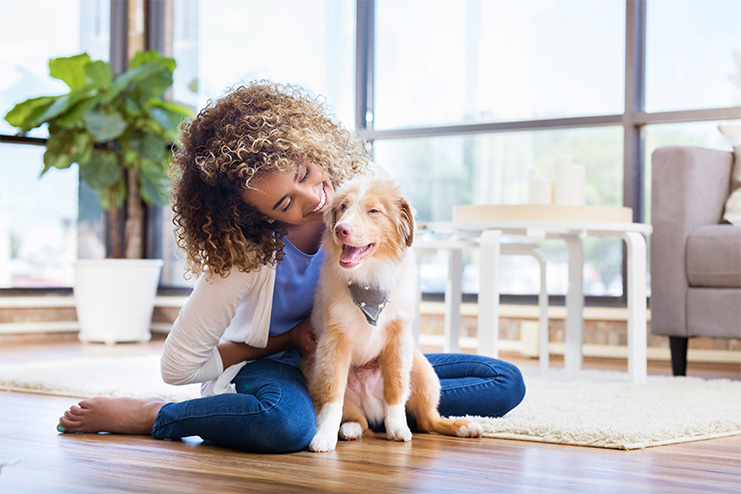9 Tips to Help You Prepare for a Puppy
The French statesman Charles de Gaulle once said, “The better I get to know men, the more I find myself loving dogs.” While we here at Quicken still have plenty of love for our fellow humans, we absolutely adore dogs — they bring such joy to our lives.
Have you found yourself wanting to bring a new puppy home but aren’t totally sure where to start? We’re glad you’re here. New pets are a giant responsibility — you’re not only socially and financially responsible for their wellbeing, but they are quite literally dependent on you for all of their needs.
If you’re getting ready to bring home a dog of your own, here’s a new puppy checklist to make your choice — and their transition to a forever home — as seamless as possible.
How to find the right puppy
Finding the right puppy isn’t quite as easy as it sounds — there are many dogs in need of a home, but there are certain unethical entities in the industry that don’t have the animals’ best interests in mind. Here are a few tips to find the right pup.
Consider adopting first
Adoption is a great way to give a dog a second chance and bring them to their forever home. Check with local shelters in the area — they’ll often have dogs of all ages, breeds, and temperaments. Are you ready to care for a special-needs puppy? Do you want to give an older adult dog a wonderful last few years? Adoption is the best avenue for you.
When adopting, most shelters will list their dogs on their website (or Instagram), where you can get an idea of who exactly is available. Once you find the dog you love, you can meet them in person — this may require visiting the shelter or the foster home they’re living in.
From there, you can arrange to bring the puppy home and pay any adoption fees, which can run from $50-500 depending on your location and the age of the dog, and may include spay/neutering and vaccinations.
Many animals in shelters come from incredibly harsh circumstances — this is a great opportunity to give a dog another chance and offer them the love they so willingly give us.
Find a responsible breeder
While there are about 2,000 licensed dog breeders in the United States alone, not every breeder works within the law. Check in with local resources, like veterinarians or dog enthusiasts, or national databases with the American Kennel Club (AKC) or Humane Society to find reputable breeders.
You want to avoid buying a dog from a puppy mill — they breed dogs in really unfortunate circumstances, and many of these dogs have behavioral or health problems.
When you find a reputable breeder, make sure you visit their facility, meet their puppies, and have an honest conversation with the person in charge. Consider asking if they offer any warranties or guarantees on their dogs, and ask these nine questions to ensure your puppy is positioned for a healthy life.
What to do before you bring your dog home
There are few better feelings in the world than finding a dog to love and provide for — once you find your puppy, it’s time to get down to puppy-proofing and preparing your home for another inhabitant. Here are some tips to consider.
Puppy-proof your home
If you’ve never lived with a puppy before, get ready for a whole lot of cute and a whole lot of chaos! By their very nature, puppies are inquisitive and energetic, which can make your home an exciting new playground. Unfortunately, your new dog can get themselves into a lot of trouble if your home isn’t puppy-proofed.
Start by surveying your space and noticing every small detail — are there small decorative candles or knick knacks at the dog’s head level that can pose a choking hazard? Take an inventory of any plants you may have in the home and make sure they aren’t toxic to canines, and make sure you secure loose cables or wires that the dog could chew through.
By puppy-proofing your home, you can lessen the risk of your puppy getting into any dangerous circumstances while encouraging them to learn skills and confidence as you nurture their creativity and explorative nature!
Puppy-proof your budget
Paying your breeder the cost to bring your puppy home or paying the dog’s adoption fee at the shelter is just the tip of the iceberg — dog ownership costs money. In the United States, providing for a puppy can set you back anywhere from $350-$2,000 a year!
Your pup needs to eat, they’ll need dog toys, and you’ll need to pick up odds and ends that come with owning a puppy as well (think pooper-scooper and carpet cleaner for messes!) However, it’s also extremely important to have some savings stashed away in case your dog has a health emergency — it’s never a bad idea to be prepared.
Start by creating a monthly budget based on your take-home pay. You’ll want to see how much you have left over that you can work with, and it also helps to calculate the costs of dog ownership — you can estimate how much you’ll spend monthly on dog food, toys, pet insurance premiums, and any medications your puppy may need (think Heartgard/Nexgard).
Need to save money for puppy purchases? We’ve got 14 ways to help!
Head to the pet store for some puppy supplies!
Unless you want your dog destroying your possessions around the house, you’re going to need to pick up some toys for the puppy to play with. Fortunately, the modern pet store has everything you need.
Dogs love to chew things, especially when they’re teething, so it’s important to have engaging chew toys for them to stimulate their brain, channel their energy, and soothe the pain of adult teeth coming in.
You’ll also need to pick up puppy food. Check with the breeder you’re using or the shelter from which you’re adopting and find out what food your pup has been enjoying. Beware of fad diets that hit the pet store shelves (often at a steep premium) — many of these dietary regimens have not been evaluated by any veterinary groups and won’t provide any extra nutrition for your pup. Also, don’t forget stainless-steel food and water bowls.
Lastly, you’ll want to buy a crate and dog bed for your pup. The benefits of crate training have been well documented, but simply put, a crate provides your puppy with a safe place of their own to unwind and chill. Start by taking a look at the different size dog crates your local pet shop offers. You’ll want one large enough for your dog to stand up and turn around in, but a crate that’s too big can feel stressful and imposing — you don’t want to put your Yorkie in a Great-Dane-sized crate!
After you bring your puppy home
Elation — that’s how it feels to bring a puppy home. Still, their transition can also come with a bit of stress for both parties, so here are a few helpful tips to encourage your dog’s socialization process, ease first day jitters, and help puppies and puppy owners get used to each another.
Create house rules
Chances are, you’ve spent a fair amount of time (and money) deliberating on your interior decor and the way your possessions are arranged. Puppies can bring other interior decor ideas to a new home. The best move? Set boundaries and create house rules from the get-go — and be consistent! Get together with your family members or the people you live with and decide what the puppy can and cannot do.
If you have priceless vases or fragile speakers on stands in your living room, you may want to discourage indoor playtime. When your pup gets the zoomies, redirect. You can take them to your backyard or to the local park to burn off some energy — just be sure to have a long lead for your dog if they’re not leash trained.
You’ll also want to decide where the dog is allowed to roam. Consider blocking off stairs while you’re on one level to prevent the puppy from going rogue and getting into trouble. You can also purchase baby gates that block doors, which can deter your dog from entering rooms that are off limits. Stay consistent with your rules and your dog will learn fast!
Start puppy training right away
Following on the heel of creating house rules (dog pun!), you’ll want to start training with your new pup as soon as you bring them home. Training your dog doesn’t mean preparing them for the National Dog Show on Thanksgiving — it’s a way to establish a rapport between you and your puppy, build their confidence, stimulate them mentally, and build trust.
Even if you’re a novice, the best thing you can do for your dog is remain consistent and provide positive reinforcement. There are many different ways to train your dog, but remember that most are very receptive to praise and food — keep plenty of training treats handy, and be sure to praise and compliment your dog when they get it right. This method is great for “Dog 101” skills like sit, shake, down, potty training, and getting them into their crate.
For more advanced training, consider hiring a professional dog trainer. Professional trainers come in many different varieties, dog training modalities, and prices — work with your budget and see how much you can spare per month for professional lessons. By continuing training, you’ll ensure your dog builds healthy self-esteem, keeps learning, and earns your trust.
Get an appointment with your vet
When you bring your puppy home, you’ll want to schedule an appointment with a veterinarian right away. If you’re a new dog owner, you might be wondering where you should take your puppy for medical care — it’s a big question!
First-time pet parents should get in touch with family or friends in the area who are pet owners and get some recommendations from them; it’s generally easiest this way. You can also take a look at local vets in the area using Google and visit their facilities before getting your dog. Make sure you feel comfortable with the vet, ensure they have a similar philosophy regarding pet ownership, and feel confident in the facility’s cleanliness.
Dogs in the care of responsible breeders and shelters will already have started veterinarian care early in their puppyhood, and most will be vaccinated against rabies, distemper, and parvovirus, as well as microchipped with an ID tag.
Depending on what age your dog is, they may need leptospirosis vaccinations, a heartworm test, flea treatment, or a regular checkup — this can all be taken care of with your first vet visit to ensure your dog is healthy and happy!
Exercise your puppy
No matter the breed, puppies have tons of energy. We all love the tired, snuggly pup, but let’s face it — they’re not going to want to snooze and cuddle all day long. Once that puppy energy switch is flipped, Dr. Jekyll, meet Mr. Hyde!
The best way to ensure your puppy is getting rid of their energy (and stress) is by exercising them regularly. It’s also important to familiarize yourself with your breed’s energy levels — don’t expect a Catahoula Leopard dog to sit on the couch all day without running them prior.
Get your puppy familiar with a leash and walk them around your home first if they’re not yet understanding. Once they’re comfortable on the leash, you can take your dog running, hiking, or walking for some exercise.
Once your dog gets comfortable off leash, you can consider taking them to a park (or a friend’s large, fenced-in backyard) to run and burn off energy. Fetch is an all-time classic, but you can also throw flying discs, create obstacle courses, take your dog swimming, or even make up your own games.
Try plenty of different activities to keep your dog stimulated and remember which ones they’re the most receptive to. By keeping your dog active, you can keep them at a healthy weight and stave off any destructive behavior around the house from boredom or pent-up energy.
Prepare to have a friend for life
Dogs are just wonderful — they love us so unconditionally and provide us with immense joy. Bringing home a puppy is one of the true pleasures in life, and they promise to be our friends ‘til the end. In order to give them the best shot at getting a great start in their new forever home, it’s crucial to meet them with boundaries, patience, and a whole lot of love.
By following the steps above, you’re ensuring your puppy gets off on the right foot to a happy, healthy life.
Quicken has made the material on this blog available for informational purposes only. Use of this website constitutes agreement to our Terms of Use and Privacy Policy. Quicken does not offer advisory or brokerage services, does not recommend the purchase or sale of any particular securities or other investments, and does not offer tax advice. For any such advice, please consult a professional.



